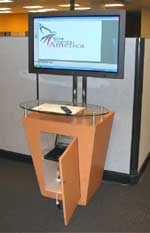News
One year later, kiosks thrive yet struggle
According to KIOSKmarketplace editor John Harrell, kiosk technology has proven its worth in the year since the 9/11 attacks. But the kiosk industry itself still faces problems, the big one being how to be heard above the din.
September 10, 2002
In early September, as the country collectively stopped to honor the heroes and ordinary people whose lives were so violently ended by the events of Sept. 11, the Pentagon dedicated a kiosk in its lobby as a way to remember the events of that heartrending day.
Computer company Hewlett Packard (HP) donated the kiosk to the Pentagon. Part of HP's Give Thanks America campaign, the sleek, uncluttered unit is the kind of attractive and informative kiosk that the industry likes to promote. It features a 42-inch plasma screen and a desktop unit with a keyboard and mouse. Using the computer, visitors to the Pentagon will be able to scroll through messages featuring celebrities, politicians, military figures, and ordinary American citizens.
 |
"This was sort of special to work with the Department of Defense," said Give Thanks America spokesman Reg Rowe. "We wanted to do something special around 9/11. This is a way to display some messages in the lobby of the Pentagon."
In its own way, however, the kiosk is more than a tribute to our country's armed forces. It is also a statement of how close, yet how far, the kiosk industry remains from achieving breakthrough status, and how the events of 9/11 have affected that quest.
Who are we?
To some, Sept. 11 is a bad day to reflect on anything beyond the thousands of Americans who were unnecessarily sacrificed that day. The day is for remembrance, after all.
But everything we do and everything we are has been changed, in big and small ways, since Sept. 11, 2001. The way we look at people; the reaction we have when we hear a low-flying jet; the occasional moment when we feel less secure than usual is all a part of the post-9/11 process.
Has 9/11 changed us? Sure it has. Can we measure it in tangible, statistical, or sociological ways? Not yet. That remains a task for experts decades removed. Just like the reaction of the American psyche caused by the assassination of President Kennedy in 1963 took years to become apparent, so too will it take time -- even in our fast-consumption world -- to measure the damage caused a year ago.
 |
KIOSKmarketplace.com editor John Harrell |
But let's forget the big picture for a minute, and take a look at the real-life traumas suffered by the kiosk industry. One of the prime examples of a killer kiosk application before 9/11 was the self-service, airline check-in kiosk. Just walk to the kiosk, flash your e-ticket, receive your boarding pass, and head straight to the gate.
For Americans, who crave convenience the same way that millions of people throughout the world desire a piece of bread and fresh water for dinner, the convenience of avoiding long airline check-in lines is irresistible. Thus kiosks, at least this one application, should have been poised for growth. Fortunately, after initial security concerns, the airline check-in kiosk has grown in stature. Projects have launched or been expanded, and most airlines view check-in kiosks as a way to provide customer convenience at a time when airport waits are growing longer, not shorter.
Overall, there has been growth in the kiosk sector. But interpreting the growth of the industry can be problematic, which is where the Give Thanks America kiosk comes into play.
Seeking input
With its 42-inch plasma screen, wood base, and computer, the Give Thanks America kiosk is a tasteful way to honor our military forces and remember why they are fighting overseas. That is why the Pentagon deployed the kiosk in its lobby.
 |
The Give Thanks America kiosk display, recently deployed in the Pentagon's lobby, showcases video greeting to U.S. military forces overseas. |
But the kiosk industry itself had little or no input into the creation of the kiosk.
The computer, of course, is a Hewlett Packard; the plasma screen was created by communication systems and equipment developer NEC Corp.; and the enclosure design and manufacture was handled by Exhibit Dynamics, a Grand Prairie, Texas-based company best known for constructing custom exhibits, not kiosks.
These are not kiosk-specific companies. That is the problem.
In a commentary that was posted on KIOSKmarketplace on Sept. 6, kiosk consultant John Purcell noted that while there are many potential kiosk deployers in the marketplace, most are surprised to learn there is such a beast as a kiosk-specific company. (See story: Defining the kiosk industry's future)
"When a company is looking at self-service devices, it normally start at their existing technology suppliers: shop fitters, design consultants, etc.," Purcell wrote. "It is only when these third parties find us in the kiosk industry that we get approached or an RFI is generated. At that stage we are already once removed from the project itself, hindering the possibility for success."
The Give Thanks America project is, in many ways, a microcosm of the problems the kiosk industry faces. While the airline industry is crazy over check-in, self-service kiosks, the mom-and-pop kiosk company is generally not benefiting from this expansion.
For every United Airlines, which has worked with kiosk developer Arral Industries on its kiosk project, there are airlines such as British Airways and Swissair, which have worked with IBM Corp.and Wincor Nixdorf, respectively. Then there is SITA, the airline network services developer. This is not a kiosk company, yet it has manufactured 1,500 kiosks that are located in more than 100 airports worldwide.
What has happened in the kiosk industry during the past 12 months is not consolidation or contraction. It is more like confusion. In pretty much every sector of the industry -- enclosures, software, peripherals, full-service providers -- there are stories of blossoming companies with steady clientele and struggling companies whose customers are delaying or abandoning kiosk plans.
Have an opinion? Do you agree with this commentary? Do you disagree? If you have a passionate opinion about this commentary, please drop us a line at editor@networldalliance.com and we will include your comments in a Reader Feedback section at the bottom of this page. |
This is not just about 9/11, it is about the economy as a whole. But after a year of observing and reporting on the kiosk industry, I have become convinced that the technology is viable and the industry is poised for growth.
The question is whether small, kiosk-centric companies can survive and prosper as the industry grows. Unfortunately for the mom-and-pop companies that have nurtured and advocated kiosk technology, the current marketplace conditions favor the IBMs of the world, companies that can afford to allow their kiosk divisions to grow in fits and starts. The farther down the food chain -- and the more focused a company is on its kiosk holdings -- the less chance for survival in a market where kiosk development is unpredictable at best.
To a large extent, 9/11 is about symbols. The Give Thanks America kiosk is a symbol of how much the country's collective psyche is affected by our military activities overseas. It's also a symbol of an industry struggling to find itself.












